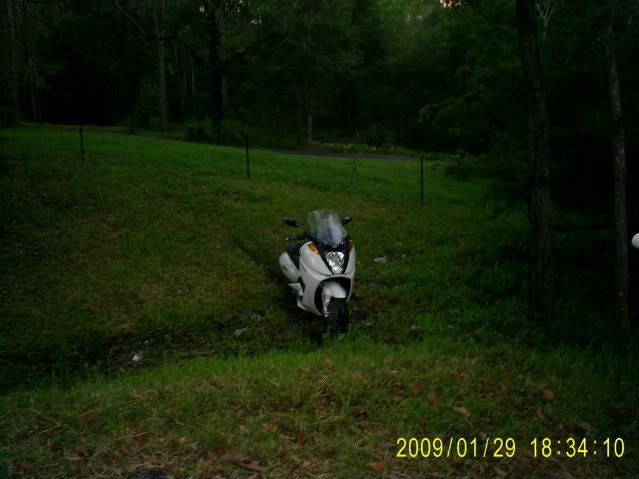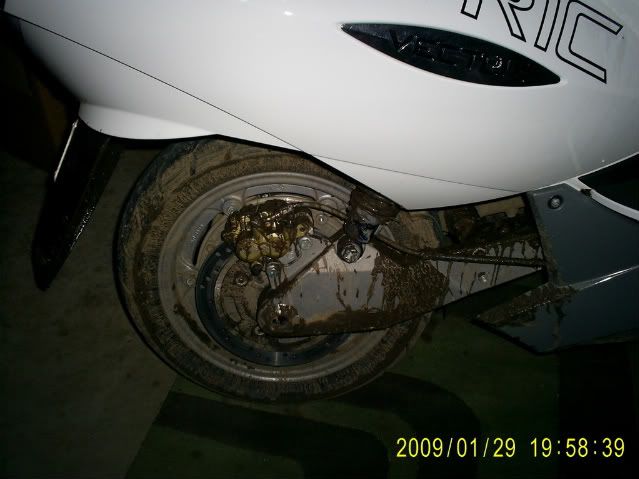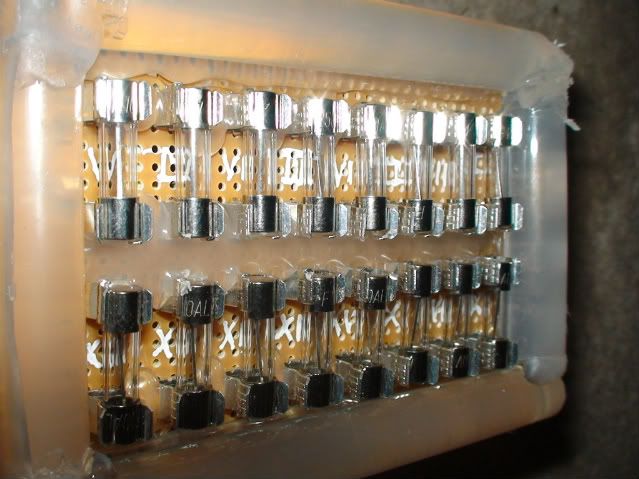Yep, stranded again, sitting in a convenience store whilst the Vectux gets a top-up so I can continue my 40km trip....
It's that cell 103-003 again, the M-BMS shows me that it is empty and being charged in reverse. It probably has a higher self-discharge rate than the other cells, because it does not reach quite the same voltage as the others at the end of the regular charging process. It did have the lowest capacity of all cells on initial testing (20A to 1.1V cutoff), but I did not put it into position 103-001 because 2 other cells had lower capacities after reconditioning and right after a full charge. Unfortunately 003 never seems to get a full charge now, because the standard BMS is very gentle and does not over-charge the string. That is with older firmware; I believe the "equalisation charge" introduced in the Oct 08 firmware update is intended to help for this kind of situation.
Once the M-BMS is completed I will be able to deliver appropriate doses of electrons to just the right places in the string, without over-charging all the good cells to bring a few rogues back in line!




if you know the culprit why do you not just buy a new cell and remove the fainting one? Would this not help to boost the range and to equalize the whole set of batteries?
i think the real question is,
*can* you buy replacement cells.
Mik, i think you are going to be the first person to find out how much they cost.
Matt
Daily Ride:
2007 Vectrix, modified with 42 x Thundersky 60Ah in July 2010. Done 194'000km
The problem is that it's not just one bad cell. But the M-BMS allows me to protect even the weakest cell in the string.
There are 12 more cells with markedly reduced capacity and swelling.
It is a lot of work to take it all apart again to replace the cells.
And I do not want to throw good money after bad money: I have spent more on tools and materials than what 13 new cells would cost, but that is an investment because it is educational on many levels and for (hopefully) many people. Buying new parts for a Vectrix without a warranty is a waste of money which I cannot afford.
Learning how to cost-effectively maintain and repair EV's is something we (as a species) cannot afford NOT to learn.
This information may be used entirely at your own risk.
There is always a way if there is no other way!
Mik,
you got a very valid point here. In a way you are a pioneer of something we will all have to go through in a not to far future, once our warranties expired and we are left to our own devices maintaining the Vectrix.
From last firmware update we know that quite some ideas of yours went straight into Vectrix deveopment. Let's hope that latest discussions about fan noise, cell supervision, and HID kits will make it into the "accessories" department too.
In a way current warranty restrictions prevent a lot of us from playing about. It would be great to have at a certain time a kind of a linux-kind of open platform.
This would definetely be a win win for Vectrix and their customers. This "model" has been quite successfull in other areas too. An good example is the wireless music streaming system of logitech (http://www.slimdevices.com). Actually all is based on streaming clients from Logitech (i.e. the vectrix hardware) but the streaming server (and all the intelleigence and user features) are based on a public domain software (i.e. non IPR parts of the Vectrix firmware). Could you imagine how much more features and ideas could be implemented with all of us helping to program it. It would be amazing. Well, now I have to leave dreaming for the rest of the day and get back to real live instead.
Norman
Ahh, almost forgot to mention, I really would like to have a head light delay (1 min?) when switching off the bike. This would allow me to open the seat compartment (which would stay illuminated), find my disc lock and secure my bike. All while the lights are still on. Now I am fiddeling about with a torch or have to switch back on the bike (after I opened the seat).
My seat does not close well, which is a bonus for me because it stays unlatched most of the time. When I park the bike at night, I just leave the key turned on until I'm done with everything.
The rubber weatherstripping on my 2008 model is much more dense than the stripping on my '07 was, so the seat won't latch unless I use a little force on it. It can't fly open when I'm on the road because my butt is against the backrest pad. Sure makes it nice when I just need to reach back for some mail to drop in the box, or grab a pair of gloves at a stoplight. :-)
My glove box is the same way. It will latch if I specifically push on the section with the little bumps, but otherwise it just sits in almost closed position. Problem there is, it will fall open while I'm riding. I'm thinking about attaching a leather snap to the surface, so I can snap the leather to secure the box but it not be latched. That way I can open it without turning the key off, but can still latch it when I want to. I go to the post office once or twice a day on this thing, and often, I just need to drop off mail, so it was annoying on the 07 to have to stop, turn the key off, open the latches, then turn the key back on, etc. etc. I also have a garage door opener attached to the inside of the glovebox door, so again, I have to turn the key off and unlatch the glove box just to open the door, then turn it back on to move the bike in.
This roadside I'm posting from has an EV friendly dentist!
The only downside to it is that it costs even more than "bringing a moped onto a parkland". HAHA! And that cost AU$ 300.- ...! But the charging itself is free.
This information may be used entirely at your own risk.
There is always a way if there is no other way!
Stuck again... big time this time!
In a real bog. If it rains heavily the Vectux will be flooded. It'a getting dark...waiting for the RACQ.
The drama started like this: Bike parked for a week, topup charge, but range too low to make it home. Cell 3 empty.
This information may be used entirely at your own risk.
There is always a way if there is no other way!
I made it home with a lot of effort!
The RACQ turned up soon (thanks!) and with a lot of improvisation and determination we managed to pull the Vectux out.
The main 2 lessons learned today:
1) The standard kit needs to include a towing adapter.
The half-rings at the front end are good, but they are too small for any of the standard equipment carried by roadside assistance trucks. It was also a really good idea to mention them in the users manual now...
We managed to jerry-rig something from old parts the tow truck driver had lying around.
2) When you give your EV a top-up charge designed to just get you home, then the efforts exhorted trying to get you out of any unexpected bogs are NOT included in this...ergo, you have to push after you had to push! That REALLY sucks!
The main safety feature of the Vectrix discovered this time:
They thought of everything! : If you get stuck in a bog (which is kind of likely because of the really low ground clearance), then the Vectrix automatically frees you up to go and call for help! It parks itself (really soon, much sooner than you thought!) on the flat bottom of the battery box and patiently waits in the mud for any further developments.
Seriously!
It just stays upright, and quite stable, in the boggy ground! That really helps.
This information may be used entirely at your own risk.
There is always a way if there is no other way!
Mik,
Have you considered putting Lithium in your Vectux? Just curious as to the pros and cons of a DIY after market upgrade.
John H. Founder of Current Motor Company - opinions on this site belong to me; not to my employer
Remember: " 'lectric for local. diesel for distance" - JTH, Amp Bros || "No Gas.
A few pictures of the debacle:
It's balancing nicely on the mud - no side stand used!

The wheel just digs in deeper until the battery case rests on the mud:

>>>>>>>>>>>>>>>>>>>>>>>>>>>>>>>>>>>>>>>>>>>>>>>>>>>>>>>>>>>>>>>>>>>>>>>>>>>>>>>>>>>>>>
Lithium? No thanks. I'll make this one work instead. The next stage of the M-BMS is almost ready:
This banana-plug-grid will allow individual as well as group recharging of the weak cells 001 o 013, and two more good ones (014 and 015) for experimental purposes.
The empty space in the box will be filled with a motor controller to adjust the speed and noise of the cooling fans, and a current clamp to measure current leaving or entering the battery.
Each tab is individually fused to protect the fuses deep inside the battery in case something gets shorted by accident:

Copious amounts of hot melt glue protect it from vibration and other hazards in the Vectux' boot, and the cables can be disconnected at the banana-plug-grid as well as at the battery to enable safe work on the M-BMS as well as battery removal without having to take it all off again.

Once this is installed I can top up the cells suffering higher self-discharge rates and the range will improve. I might also be able to shift charge from the good cells to the weak ones on the road.
But most importantly I will be able to measure how many tabs are really needed to manage the 102 cell NiMH string more appropriately.
This information may be used entirely at your own risk.
There is always a way if there is no other way!
How did you manage to get the bike in there?
wow .what the. how the . where the .??????????
come on what was you doin.t to get there .. was you chasing the bog woman that ive heard about ??
or is it dear chaseing season ?
please please let us all know
orr deer i say it was it an electrical probblem
vectrix the new bog bike ???????????????????????
come on its got us all chuckle in but hope you didn.t hurt your self ..kev
Sorry, the RACQ turned up just as I was typing away the "how it happened"...
So here is the rest of it, continuing on from the initial roadside posting of:
I drove through a boom gate to get to the power supply of a derelict septic system (seriously, the smelliest emergency topup charge I have had to take so far. But beggars can't be choosers...). I drove through just after a car had triggered it to open. I thought I could either drive around the boom later on (after the topup charge), or that it would open automatically, like for the cars going through.
You can see the very tip of the boom in the photo above. So after the 20min top up charge I reversed down the grassy slope a little bit, hoping I could then drive up again and so get around the boom. But the wheel started to spin and to dig itself in, halfway down to the drainage channel. A little later I decided to drive backwards (further down) so that I could attempt to get back up by picking up some speed on the creek bed. I got stuck in the lowest part at first, but somehow did manage to work my way backwards up the opposite bank for a meter or so.
Then I tried to accelerate through the channel and up the other side, but got terminally stuck in the lowest part. And that's when I took the above picture.
It was a real mess to clean up all the mud from the hub motor, brakes, shock absorbers etc, I'm sure there is more mud left somewhere...
This information may be used entirely at your own risk.
There is always a way if there is no other way!
Parked and recharging, not stranded yet...for I have come better prepared this time!
The Icebox makes a nice seat whilst waiting for cells 1 to 6 to recharge from an 8 cell AA NiMH pack.
43km gentle riding, no babying though before cell 3 was being charged in reverse again.
I plugged in a single 9Ah NiMH cell into the plugs for cell 3 and continued on, but this was not sufficient to stop cell 3 from reverse charging on this narrow 80km/h road.
I had to turn the hazard lights on and pull over again after another km.
When the hazard lights are on whilst riding then the beeper starts beeping! There is nothing like a real road test...
With the alternating blinking pattern the beeper annoys at double speed.
The auxiliary battery pack is slightly hot by now - 51deg C.
This information may be used entirely at your own risk.
There is always a way if there is no other way!
I made it home with just a tiny bit of pushing on the drive way to keep cell 1 from reverse charging. About 3km extra range without cell damage!
But first back to the roadside:
After about 40min the aux pack started to get a bit cooler again and I figured that it is not going to put much more into the Vectux cells. I disconnected it and put the single 9Ah cell onto cell 3 and rode off.
That worked well for cell 3, but cell 1 could not cope for long and needed babying.
All this happened with 6/17th left on the fuel gauge without a noticed drop in performance. Before I had the M-BMS I would have continued to ride normally, then at 5/17th I would get a battery warning and a performance drop, followed by the sudden disappearance of all remaining bars. The stock-BMS just does not get it when a few cells are being charged in reverse; it probably needs about a dozen cells in reverse charging mode to notice it! And the cell which was empty first gets the most reverse charging and the most additional damage and ages faster and faster, until it fails totally.
The reverse charging voltage seems to halt at -0.25V for some reason.
If you draw 100A whilst riding with an empty cell, that cell creates 0.25V * 100A = 25W of heat. Imagine an incandescent light bulb of 25W power coming on inside that cell - it will get very hot very quickly.
That's why the disappearing bars syndrome in a Vectrix is soon followed by baTHOt warnings - at least if the weak cell(s) are located near one of the 12 temp sensors.
----------------------------------------------------------------------------------------
I'm happy with the results of my auxiliary battery pack testing today:
A) The fuse (10A) in the banana-plug-grid in the boot did not blow when I had the 9Ah NiMH cell connected to cell 3 whilst it was being charged in reverse during riding. I did of course not do this for more than a few seconds, and the fuse might have been close to blowing by then. But if the auxiliary cell gets connected early enough then it should be OK as far as the fuse is concerned. The 9Ah cell is capable of producing over 25A, probably much more.
B) The 8s NiMH AA cell pack did recharge the cells 1 to 6 somewhat. It's "proof of concept" before I spend more money on a pack made of larger cells. The 8 cells should be able to be kept fully charged by the 12V (actually 11.8V) outlet in the glove box. It also fails to provide the specified 500mA - more like 300mA continuously! But it will be enough to trickle charge the 8s string during recharging.
(More details there: http://www.endless-sphere.com/forums/viewtopic.php?f=14&t=6853&st=0&sk=t&sd=a&start=45#p134010 )
If I make an 8 cells string out of larger capacity cells (like the 9Ah cell), and plug it in half-way into a long ride, or even at the beginning, then I might be able to prop up the weak capacity cells so they last as long as the good cells. The larger 8-cell pack could still be trickle charged automatically in the glove box and be ready whenever needed!
The other thing I realised whilst sitting on my comfortable ice-box on the roadside today was this: I can also make an emergency charger (just for the weak cells) which plugs into a car cigarette lighter! BINGO! 13V should charge about 9 cells - faster if less cells are connected....I've got 10A fuses and 15A cable going to those cells, it just needs some tests.
24V from a truck would be even better!
This information may be used entirely at your own risk.
There is always a way if there is no other way!
Sounds like you are finding out that not having a BMS for each cell might get you through the warranty period (likely with some reduced performance or range), but quite possibly there will be "hidden" cell damage?
Cheers, Gary
XM-5000Li, wired for cell voltage measuring and logging.